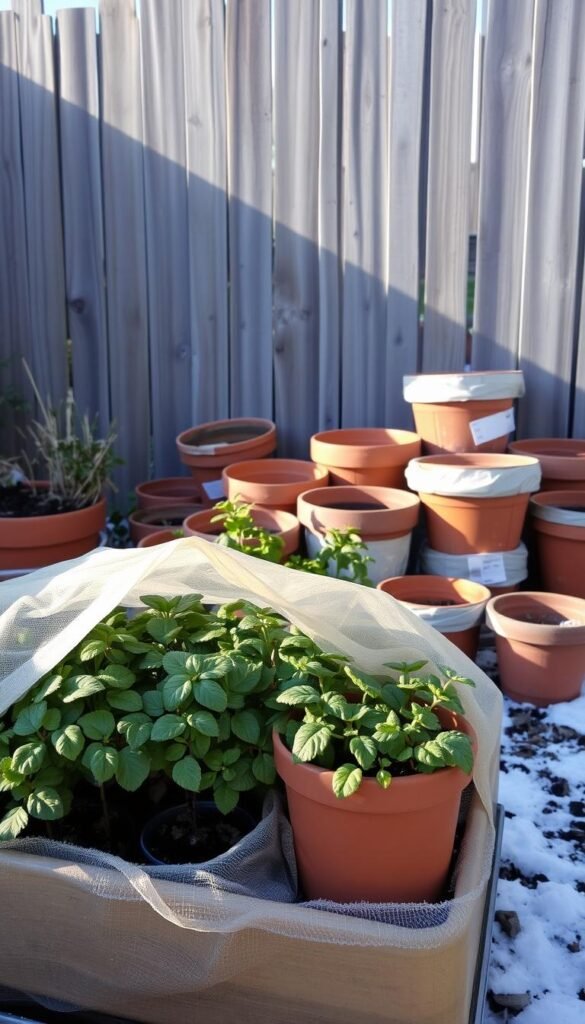When chilly weather arrives, your potted greenery faces unique challenges. Unlike garden beds, containers lack the insulating benefits of soil depth, leaving roots exposed to sudden drops in temperatures. This makes even hardy varieties more susceptible to frost damage—especially younger or delicate specimens.
Why does this matter? A single freeze can wilt leaves, stunt growth, or even kill your favorite blooms. But don’t worry! With the right approach, you can keep your potted treasures thriving through the coldest months. This guide shares simple, effective ways to create a cozy environment for your plants.
You’ll discover how to use materials like bubble wrap or garden fleece to shield pots. Moving sensitive varieties indoors during extreme cold snaps also helps. For those who want to extend their growing season, strategies like cold frames add weeks of productivity for crops like kale and tomatoes.
Remember: preparation is key. Sudden temperature swings stress plants, so consistent protection matters. By understanding your greenery’s needs and acting early, you’ll transform winter from a threat into a manageable part of your gardening journey.
Understanding How Frost Affects Your Container Plants
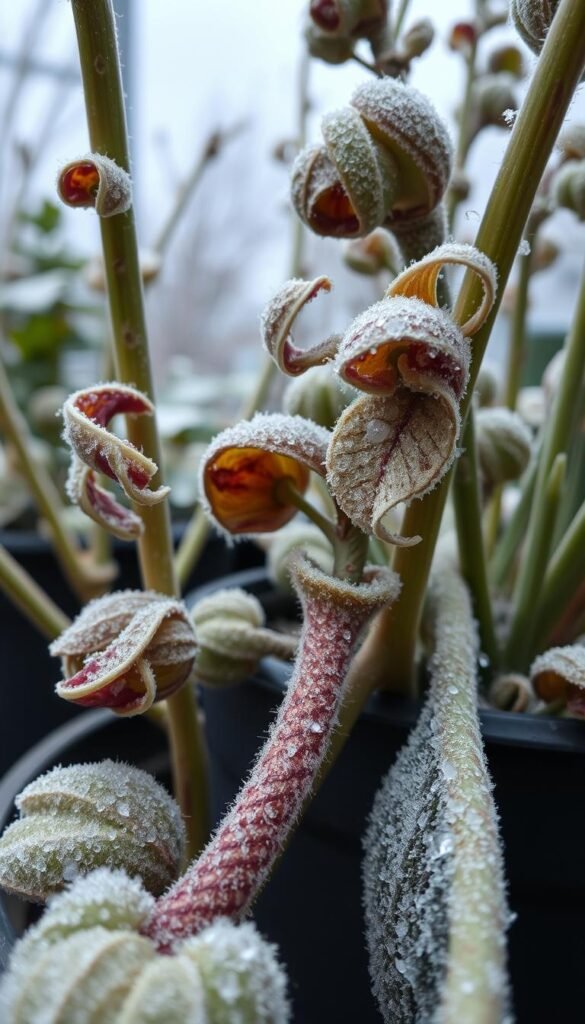
Those crisp mornings bring more than just a chill—they signal hidden risks for your potted greens. Frost doesn’t just nip at leaves; it disrupts cellular structures, leaving once-healthy growth vulnerable. Let’s unpack how to spot trouble and keep your favorites resilient.
Recognizing Frost Damage Signs
Early detection saves lives—plant lives, that is. Look for leaves turning black or brown, especially at the tips. New growth may appear limp or twisted, like crumpled paper. In shrubs, stems might split or develop sunken patches. Check your perennials daily when forecasts dip below freezing—damage often starts subtly.
The Impact of Cold on Plant Growth
Cold doesn’t just cause visible harm. It slows nutrient uptake in roots, starving your greens even if they look okay. Shrubs might skip spring blooms, while perennials could take months to recover. Young plants suffer most, but even mature ones struggle when soil in pots freezes solid. A single frosty night can delay growth cycles by weeks.
Quick action matters. Move pots to sheltered spots at the first warning. Cover sensitive varieties with breathable fabric—old bedsheets work wonders. Remember: healthy plants bounce back faster, so keep feeding them until dormancy kicks in.
Choosing the Right Plants and Containers for Winter

Your potted companions need smart choices to survive seasonal shifts. Start by grouping species with similar cold tolerance—this simplifies care routines. Some greenery thrives in crisp air, while others demand extra TLC when mercury drops.
Spotting Delicate Varieties
Frost-tender plants like succulents or tropicals show distress quickly. Check their leaves—thin, glossy foliage often means lower cold tolerance. Herbs such as basil and rosemary may survive light frosts but struggle in prolonged freezes. Always research each plant’s USDA hardiness zone before potting.
Pot Materials That Fight the Freeze
Not all containers handle winter equally. Terracotta cracks when frozen, while plastic becomes brittle. Opt for double-walled resin or wood planters—they buffer roots from rapid temperature swings. Metal pots conduct cold faster but work well for hardy evergreens if elevated off frozen ground.
Position your pots where morning sun warms them during spring thaws. South-facing walls radiate heat absorbed during daylight hours. For soil, mix in perlite or bark to improve drainage—soggy roots freeze faster. A layer of gravel at the pot’s base adds insulation against icy surfaces.
Preparing Your Container Garden for the Winter Season

The secret to thriving greenery in cold months lies in mastering your garden’s unique environment. Start by observing how sunlight and wind interact with your space—these factors determine which spots stay warmer longer. Sheltered areas near walls or fences often create natural shields against harsh conditions.
Assessing Your Garden’s Microclimate
Track sunlight patterns for a week. South-facing zones get more warmth, while north-facing corners stay cooler. Wind tunnels between buildings? They amplify freezing effects. Use tall plants or temporary barriers to deflect gusts. Elevate pots off cold surfaces like concrete—wooden pallets work great for insulation.
Timing Your Winter Preparation
Begin protection measures 2-3 weeks before your area’s first average frost date. Check local seasonal trends online—coastal regions often delay cold snaps compared to inland zones. Tender annuals need early attention; move them first when nights dip below 50°F. Apply mulch before heavy rain forecasts—it locks in moisture better than dry soil.
Watch for sudden drops in evening temperatures. Group pots together near heat-retaining structures when a freezing alert hits. This clustering creates a microclimate that buffers against rapid growth stalls. Remember: consistent care beats emergency fixes every time.
Winter-Proof Container Gardening: Protecting Plants from Frost
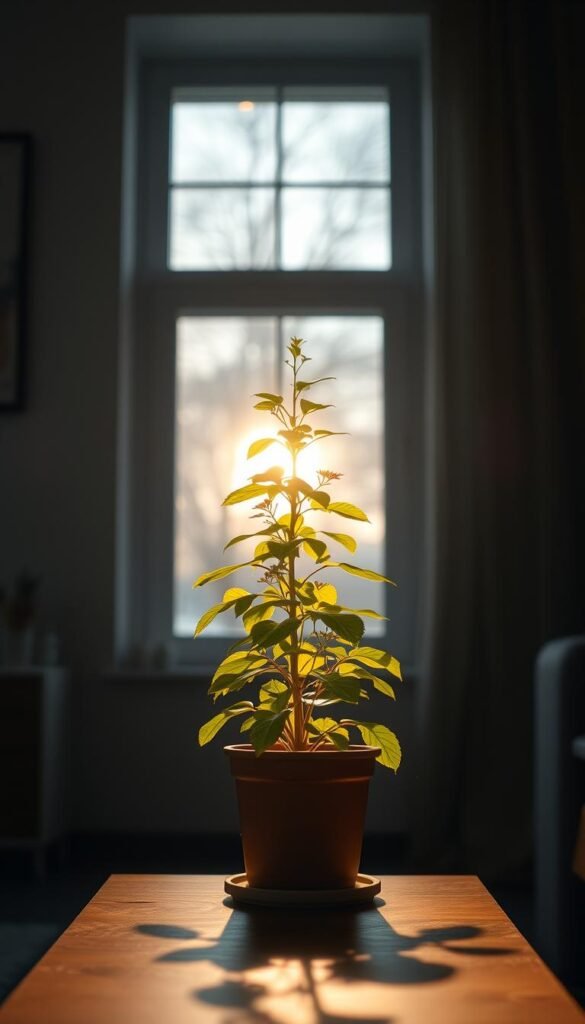
As days shorten and temperatures dip, your outdoor potted greens need a solid strategy. Relocating sensitive varieties to sheltered spaces and boosting insulation around roots can make all the difference. Let’s explore how to execute these moves smoothly while keeping your greenery thriving.
Bringing Potted Plants Indoors
Start by moving plants to a garage or covered porch before fall evenings hit freezing. Inspect leaves for pests first—you don’t want hitchhikers indoors. Gradually acclimate them over 3-4 days to avoid shock from sudden light changes.
Spaces like a garage with windows work best for partial sunlight. Group pots together to maintain humidity. If temps drop below 20°F, add a thermal curtain between plants and drafty doors.
Using Mulch and Insulation Effectively
Apply 3-4 inches of straw or shredded bark up to the container’s rim. This layer traps heat and prevents soil from freezing solid. For extra risk reduction, wrap pots with blankets or bubble wrap—secure them using twine.
| Material | Best Use | Protection Level |
|---|---|---|
| Straw | Root insulation | Moderate (down to 25°F) |
| Fleece blankets | Whole-plant cover | High (down to 15°F) |
| Bubble wrap | Pot wrapping | Extreme cold buffer |
Skip these steps, and you risk cracked pots or dead roots by mid-fall. One Ohio gardener lost 12 herbs last year by delaying mulch application—don’t repeat that mistake!
Utilizing Sheltered Spots and DIY Greenhouse Setups
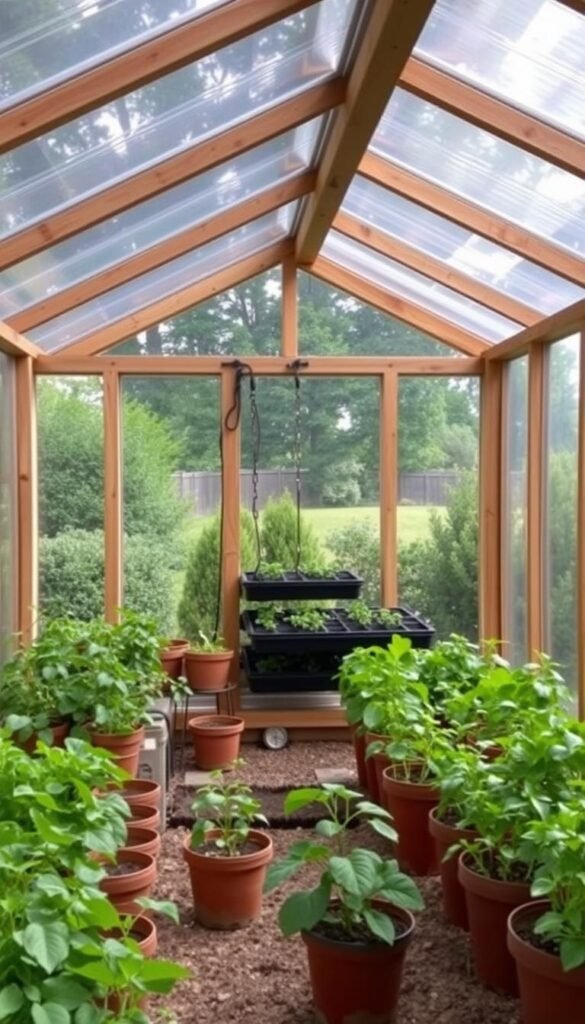
Transform overlooked spaces into cozy retreats for your greenery when frost threatens. South-facing walls, covered patios, or even balcony corners can become lifesavers. These areas absorb daytime heat, creating microclimates that stay 5-10°F warmer than exposed spots.
Creating a Cozy Indoor Garden Space
When cold temperatures drop below 20°F, move potted plants to bright indoor areas. Sunny windowsills or utility rooms with grow lights work well. Cluster plants together—this boosts humidity and slows soil drying. Add pebble trays filled with water beneath pots for extra moisture.
Setting Up Cold Frames and Grow Tunnels
Build affordable protection using old windows or PVC pipes. A basic cold frame takes 30 minutes to assemble: hinge a glass pane over a wooden box. For rows of plants wintering outdoors, drape poly film over hoops to form a tunnel. Secure edges with bricks to block wind.
| Material | Setup Time | Temp Boost |
|---|---|---|
| Straw bales | 10 minutes | +8°F |
| Fleece covers | 5 minutes | +12°F |
| Poly film tunnel | 45 minutes | +15°F |
| PVC hoop house | 1 hour | +20°F |
Check covers daily—ventilate when sunlight raises interior temps above 50°F. One Minnesota gardener kept kale alive at -10°F using layered straw and plastic sheeting. Remember: these setups protect plants best when paired with proper watering and insulation.
Implementing Effective Covering Methods
Shielding your greenery from icy nights starts with smart cover choices. The right material acts like a warm hug for your pots, trapping heat while letting air circulate. Let’s break down how to match covers to your plants’ needs and secure them properly.
Selecting Suitable Protective Covers
Not all covers work equally against freezing temperatures. Horticultural fleece blocks frost but stays breathable—ideal for delicate blooms. Bubble wrap insulates pots well but shouldn’t touch leaves directly. Old blankets offer heavy-duty protection but may trap moisture if left on too long.
| Material | Pros | Cons |
|---|---|---|
| Fleece | Lightweight, reusable | Needs anchoring in wind |
| Bubble wrap | Traps heat effectively | Non-breathable |
| Blankets | Blocks harsh cold | Can smother plants |
Techniques for Wrapping Pots and Plants
Drape covers over stakes or frames to prevent contact with foliage—direct touch causes ice burn. When you water plants, do it midday so excess moisture evaporates before nightfall. For cold-hardy varieties, focus insulation around the pot’s base instead of wrapping entire plants.
In your vegetable garden, use row covers secured with rocks. Potted herbs need individual wraps—burlap sacks work great. Always make sure to remove covers by mid-morning on sunny days. Trapped heat can overstress plants, undoing your protecting plants efforts.
Adjust methods for extreme cold: layer fleece over bubble-wrapped pots. Check forecasts nightly—if freezing temperatures dip below 15°F, add a second cover. Just make sure to leave gaps for airflow. One gardener saved her rosemary by using clothespins to attach fleece to bamboo stakes, creating a tiny greenhouse effect.
Optimizing Watering and Soil Care in Frost Conditions
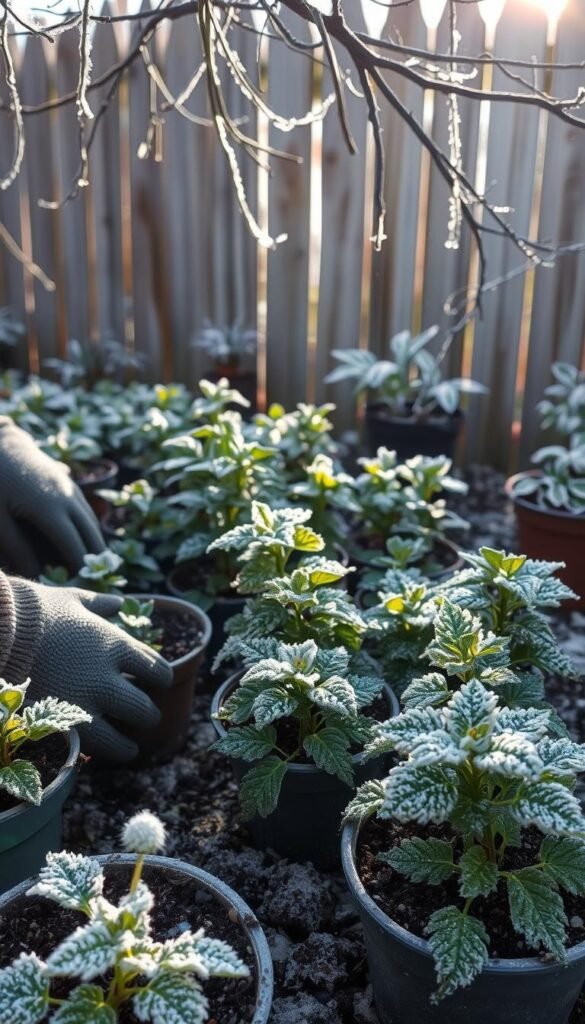
Mastering moisture control becomes your secret weapon against icy conditions. The right balance keeps roots hydrated while creating insulation—vital for frost protection when temperatures plummet. Let’s explore how timing and technique can shield your greenery.
Morning Watering Strategies
Watering at dawn gives soil time to absorb warmth before nightfall. This creates a thermal buffer that slows freezing around roots. Avoid evening hydration—trapped moisture turns into ice, damaging delicate root systems.
Managing Soil Moisture for Insulation
Damp (not soggy) soil holds heat better than dry dirt. Check moisture by poking a finger 2 inches deep. If it’s dry, water lightly. For plants indoors during freezes, reduce frequency—they drink slower in cooler indoor air.
| Soil Care Method | Purpose | Best For |
|---|---|---|
| Organic mulch | Retains heat & moisture | All potted varieties |
| Perlite mix | Improves drainage | Succulents, herbs |
| Gravel layer | Prevents root rot | Overwatered plants |
Wrap pots with bubble wrap when forecasts drop below 25°F. Secure it with twine, leaving the soil surface uncovered for airflow. Pair this with a 3-inch mulch layer for double frost protection.
Adjust your routine as seasons shift: water less in dim winter light but maintain consistent checks. These tips protecting your plants ensure they’ll emerge healthy when spring warmth returns.
Enhancing Insulation with Mulching and Wrap Techniques
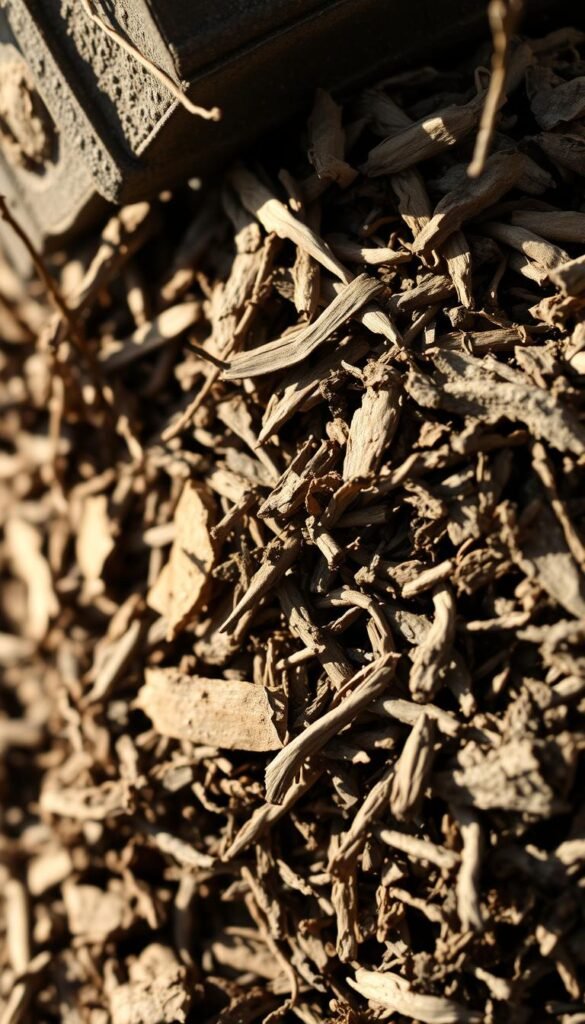
Your potted greens need extra care when the mercury plummets. Organic mulch acts like a cozy blanket, creating a buffer against sudden cold snaps. This simple layer does more than just keep roots warm—it maintains stable conditions for your greenery to endure winter’s mood swings.
Why Organic Mulch Works Wonders
Straw, shredded leaves, or bark chips regulate moisture in wet soil by absorbing excess water. This prevents root rot during thaws while locking in hydration when temperatures drop. For container plants, a 2-3 inch layer shields the planted ground from rapid freezing.
- Preserves soil structure during freeze-thaw cycles
- Reduces stress on delicate new growth
- Decomposes over time, feeding earthworms and microbes
Apply mulch after the first hard frost in your area. Keep it 1 inch away from stems to avoid rot. Pair with bubble wrap around pots for double defense—especially for young container plants in exposed locations.
In regions with erratic weather, refresh mulch monthly. This maintains consistent insulation as materials settle. One Colorado gardener saved her rosemary by adding pine needles each time snow melted—her new growth stayed vibrant all season!
Additional Tips for a Thriving Winter Garden
Staying ahead of winter’s curveballs requires smart observation and quick adjustments. Your plants pots depend on daily attention as temperatures swing. Let’s explore how to turn weather tracking into your secret gardening superpower.
Smart Forecast Tracking Tactics
Check local forecasts every morning and evening. Look for phrases like “wind chill advisory” or “freeze warning.” These signal when to move plants pots to sheltered spots. Apps like NOAA Weather offer hour-by-hour temp graphs—perfect for timing your interventions.
Your USDA hardy zone determines which strategies work best. Zone 6 gardeners might use heavy mulch, while Zone 9 folks focus on rare frost events. Bookmark your zone’s average frost dates—they’re your seasonal playbook.
| Tool | Frequency | Benefit |
|---|---|---|
| Weather Apps | Daily | Real-time alerts |
| Frost Alerts | Weekly | Prep time for covers |
| Zone Maps | Seasonal | Tailored protect frost plans |
Small changes bring big results. Shift pots closer to walls when icy winds approach. Swap plastic covers for breathable fabric if temps hover near freezing. Remember: your hardy zone isn’t static—climate shifts mean staying flexible is key to success.
Wrapping Up Your Winter Container Gardening Journey
Your efforts to nurture potted greens through cold months can yield vibrant results with the right approach. By spotting early signs of frost damage—like discolored leaves or split stems—you’ll act swiftly to save stressed varieties. Choosing sturdy pots and hardy species suited to your zone builds a strong foundation, while breathable wraps and thermal covers add crucial insulation.
Remember: relocating delicate greens to garages or DIY setups like cold frames creates safe havens during deep freeze events. Pair these moves with morning watering and soil moisture checks to maintain root health. Proactive care—whether mulching, clustering pots, or tracking forecasts—dramatically cuts risks.
With these strategies, you’re equipped to handle whatever winter throws your way. Each step you take, from selecting materials to adjusting covers, strengthens your greenery’s resilience. Now go enjoy that thriving garden—you’ve earned it!

